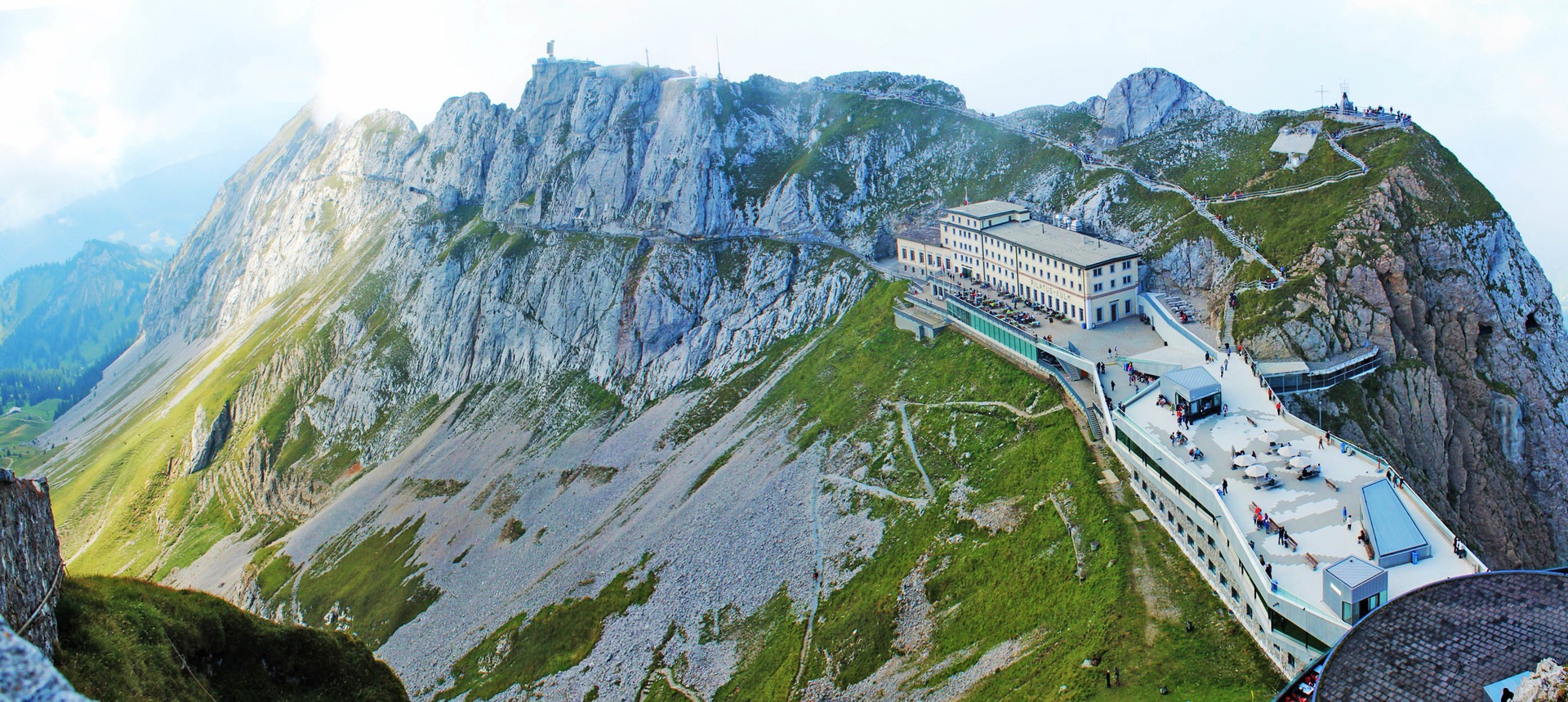You are here
Mount Pilatus, a mountain massif comprised of several peaks, towers over Lucerne and the quaint community of Alpnach smack-dab between Switzerland’s Obwalden and Nidwalden cantons. Mark Twain may have called the nearby Rigi "Queen of the Mountains," but with its three distinct peaks gracing its crest, Pilatus wears the rocky crown. It is also one of the country's most popular tourist attractions, mainly because Pilatus boasts the steepest cogwheel railway in the world, making the incredible summit easy and accessible for those who do not wish to hike it themselves.
Historically, Pilatus’ prominence also made the mountain the subject of much folklore. In the 14th century, for instance, citizens of Lucerne were forbidden from venturing unauthorized to the mountain for fear of angering various supernatural entities, including the ghost of tyrannical Roman governor Pontius Pilate (who was laid to rest in Lake Lucerne near the base of Pilatus) and even fire-breathing dragons. Some claim a dragon skeleton was recovered from the caves beneath the mountain, and others still believe that on pale moonlit nights, you can see shadows of the dark scaly wings sweeping over the land.
Matthorn (not to be confused with the iconic Swiss mountain Matterhorn) is Pilatus’ twin peak, rocky and precipitous in makeup and generally overlooked in favor of its more accessible sister.
Though the summit of Pilatus is easy to reach without all the work, that’s not what we’re here for, and the hike is a wonderful experience in and of itself, especially when adding the Matthorn summit.
There are two ways to hike to the summit of Pilatus:
- Departing directly from the Alpnachstad train station and following the miserably steep trail up the front side of the mountain;
- Hike up the backside of the mountain and ascend via the more gradual saddle between Matthorn and Pilatus. The latter, of which is detailed here, is still strenuous, but a far more pleasurable hike.
To take the second route, park at the car park near Lütholdsmatt restaurant, just outside Alpnach, and begin hiking upward through spotted forest and lots of farmland filled with friendly dairy cows. Apparently there’s a reason for the name of Lucerne dairy products! While the cows are cute and friendly, their presence also means that you absolutely should not drink water found near the trail, even with a filter. Make sure you bring a sufficient amount to at least reach the lodge on top of Pilatus. For the first 3.5 kilometers, you’ll be roughly following Meisibach stream with no real intersections or splits, making it incredibly easy to navigate. Just keep following the trail upward into the saddle.
After 4.8 kilometers, you will reach the top of the saddle (1,867 m), where the trail splits. To the right, it leads to Matthorn; to the left, to Pilatus; and straight, it goes back down the front side of the mountain (the miserably steep trail that is also an option for the hike).
The trail leading up to Matthorn is steep and rocky, lined with thick steel chains and bits of rebar to support the looser sections of rock. The summit of Matthorn (2,041 m) is bald and prominent, with a lovely grassy knoll perfect for eating lunch in peace before braving the crowds that await on Pilatus. Take in the 360-degree panoramic views of both Obwalden and Nidwalden cantons, Lake Sarnen, Lake Lucerne, and the true Swiss alps in all their dramatic glory rippling like blue waves in the distance.
To continue to Pilatus, descend Matthorn the same way you came into the saddle and instead climb the trail going up the opposite side. This trail is equally steep as its twin, gaining 167 meters, but covered in loose scree rather than solid stone. The sign in the saddle will tell you the time estimate for the 1 kilometer ascent is 40 minutes.
Upon reaching Pilatus Klum (2,038 m), suddenly step from the wilds of the Swiss Alps into a touristic scene of modernity, complete with a grand hotel and crowds of tourists that hitched a ride on the tram. It can feel strange suddenly walking amongst those who didn’t earn the summit in the same way as you.
If you can bear the crowds of tourists wandering the concrete platform for a brief hundred meters, you can once again escape to the highest summit of the Pilatus massif, Tomlishorn (2,128 m), another 1.5 kilometers away from Pilatus Klum via the southwest ridge, gaining another total 147 meters in elevation. Signs will point you in the proper direction form Pilatus Klum. If you don’t want to hike quite that far, you can make the shorter trek up to two different viewing platforms, "Aussichtsplattform" in German, on peaks on either side of the hotel.
If you want to make the excursion a shortened loop, rather than hike all the way back, you can always take the tram down the mountains, but make sure you bring enough money (about 36 Swiss Francs) to buy a ticket. Plus, then you can say you’ve ridden on the world’s steepest cogwheel railway!
Logistics + Planning
Current Weather: Powered by Dark Sky






























Comments
Sign In and share them.